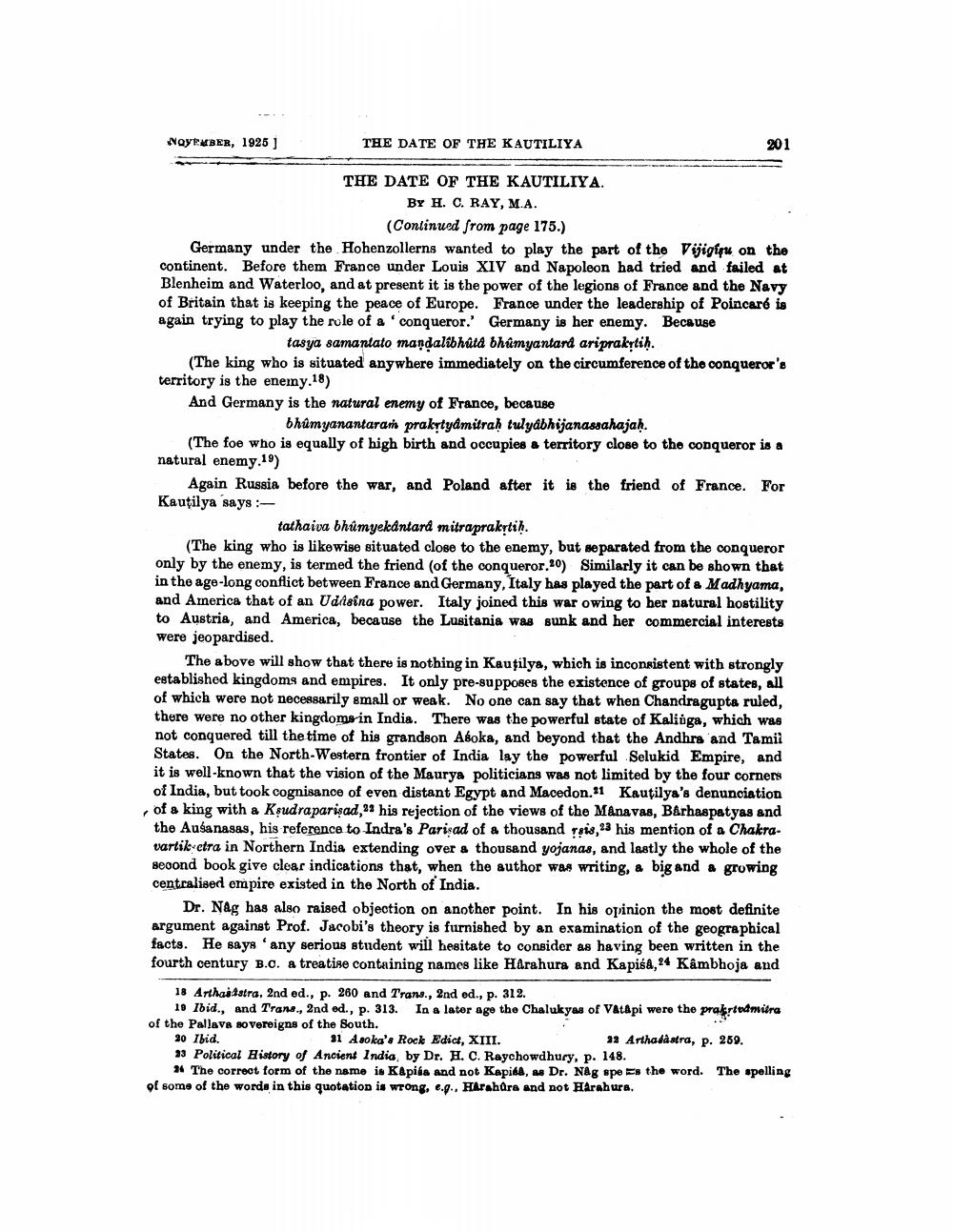________________
NOYEXBER, 1925)
THE DATE OF THE KAUTILIYA
201
THE DATE OF THE KAUTILIYA.
BY H. C. RAY, MA
(Continued from page 175.) Germany under the Hohenzollerns wanted to play the part of the Vijigipu on the continent. Before them France under Louis XIV and Napoleon had tried and failed at Blenheim and Waterloo, and at present it is the power of the legions of France and the Navy of Britain that is keeping the peace of Europe. France under the leadership of Poincaré is again trying to play the role of a 'conqueror.' Germany is her enemy. Because
tasya samantato mandalibhúta bhůmyantard ariprakrti). (The king who is situated anywhere immediately on the circumference of the conqueror's territory is the enemy.18) And Germany is the natural enemy of France, because
bhúmyanantaran prakrtyámitrah tulyábhijanassahajah. (The foe who is equally of high birth and occupies a territory close to the conqueror is a natural enemy.19)
Again Russia before the war, and Poland after it is the friend of France. For Kautilya says :
tathaiva bhúmyekäntard mitraprakytih. (The king who is likewise situated close to the enemy, but separated from the conqueror only by the enemy, is termed the friend of the conqueror.20) Similarly it can be shown that in the age-long conflict between France and Germany, Italy has played the part of a Madhyama, and America that of an Udasina power. Italy joined this war owing to her natural hostility to Austria, and America, because the Lusitania was sunk and her commercial interests were jeopardised.
The above will show that there is nothing in Kautilya, which is inconsistent with strongly established kingdoms and empires. It only pre-supposes the existence of groups of states, all of which were not necessarily small or weak. No one can say that when Chandragupta ruled, there were no other kingdomsrin India. There was the powerful state of Kalinga, which was not conquered till the time of his grandson Asoka, and beyond that the Andhra and Tamii States. On the North-Western frontier of India lay the powerful Selukid Empire, and it is well-known that the vision of the Maurya politicians was not limited by the four corners of India, but took cognisance of even distant Egypt and Macedon.21 Kautilya's denunciation of a king with a Kșudraparişad, 22 his rejection of the views of the Månavas, B&rhaspatyas and the Aušanasas, his reference to Indra's Parisad of a thousand ris, 23 his mention of a Chakravartik-etra in Northern India extending over a thousand yojanas, and lastly the whole of the second book give clear indications that, when the author was writing, a big and a growing centralised empire existed in the North of India.
Dr. Nag has also raised objection on another point. In his opinion the most definite argument against Prof. Jacobi's theory is furnished by an examination of the geographical facts. He says 'any serious student will hesitate to consider as having been written in the fourth century B.C. a treatine containing names like Harahura and KapiśA, 24 Kâmbhoja and
18 Arthasstra, 2nd ed., p. 260 and Trans., 2nd ed., p. 312.
10 Ibid., and Trane, 2nd ed., p. 313. In a later age the Chalukya of Vatapi were the praktumvitra of the Pallava sovereigns of the South. 20 Ibid. 31 A soka's Rock Edict, XIII.
33 Arthadastra, p. 269. 33 Political History of Ancient India, by Dr. H.C. Raychowdhury, p. 148.
# The correct form of the name is Kapila and not Kapiba, as Dr. Nag spe Es the word. The spelling of some of the words in this quotation is wrong, e.g.. Harahůrs and not Harshura.




